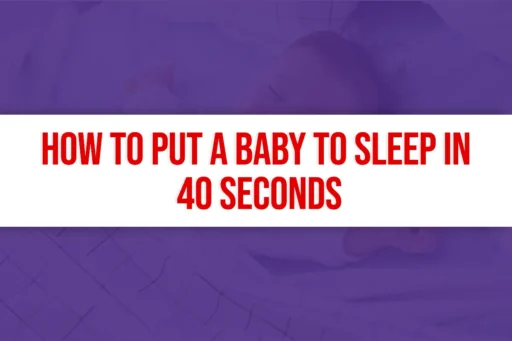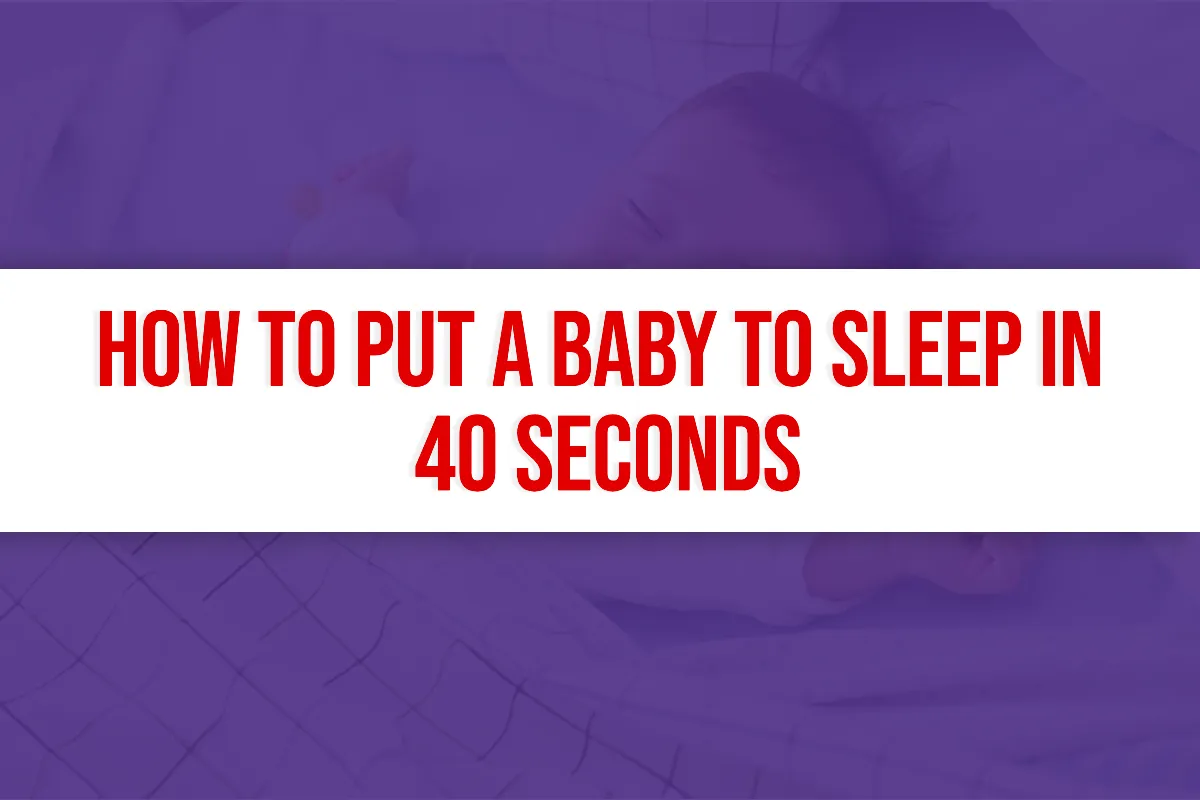Putting a baby to sleep quickly can seem impossible. But is it really?
Here’s a surprising method that may help you put your baby to sleep in just 40 seconds. Every parent dreams of a quick and peaceful bedtime routine. Sleepless nights can be hard on both the baby and the parents. This guide will share a simple and effective technique to help your baby drift off in under a minute.
It’s not magic, but a tried and tested method that many parents swear by. Get ready to discover how you can make bedtime a breeze and enjoy more restful nights.

Creating A Calm Environment
Creating a calm environment is key to helping your baby sleep quickly. Babies sense their surroundings and react to it. A peaceful setting can make a huge difference. Here are some tips on how to create that perfect calm environment.
Setting The Mood
Dim the lights in the room. Bright lights can keep your baby awake. Soft lighting signals that it’s time to sleep. You can use a night light for a gentle glow.
Play soft, soothing music or white noise. This can drown out any background noise. It also creates a consistent sound that can be comforting.
Keep the room at a comfortable temperature. Too hot or too cold can make it hard for your baby to sleep. Aim for a moderate temperature that feels just right.
Eliminating Distractions
Remove any toys or objects that might catch your baby’s attention. A clutter-free space helps your baby focus on sleep. Keep the crib empty, except for a fitted sheet and a sleep sack.
Turn off any screens or electronic devices. The light and sounds from these can be distracting. Screens can also interfere with your baby’s natural sleep cycle.
Limit any outside noise. Close windows and doors to block out sounds from outside. If needed, use a white noise machine to cover any loud noises.
The 40-second Technique
Are you struggling to put your baby to sleep? The 40-Second Technique might be the solution you need. This method promises to calm your baby and have them asleep in under a minute. Follow our guide to make bedtime easier for both you and your baby.
Step-by-step Guide
- Prepare the room: Dim the lights and ensure the room is quiet.
- Swaddle your baby: Wrap them in a soft blanket for comfort.
- Hold your baby: Gently cradle them in your arms.
- Use a soothing voice: Speak softly or hum a lullaby.
- Gentle rocking: Rock your baby slowly and steadily.
Common Mistakes To Avoid
- Not preparing the room: A bright or noisy room can keep your baby awake.
- Too tight swaddle: Ensure the swaddle is snug but not too tight.
- Rough handling: Always handle your baby with care and gentleness.
- Loud noises: Speak softly to avoid startling your baby.
- Fast rocking: Slow, steady movements are more calming.
Soothing Sounds And Rhythms
Getting a baby to sleep can be a challenge. Soothing sounds and rhythms can help make this process easier. These sounds can calm the baby and promote sleep. Let’s explore some effective methods to use soothing sounds and rhythms.
Effective Lullabies
Lullabies have been used for centuries to help babies sleep. They provide a sense of comfort and security. Here are some tips for choosing and using lullabies:
- Choose soft and slow melodies. These are more calming.
- Sing or play familiar tunes. Babies like repetition.
- Keep the volume low. Loud sounds can be startling.
| Lullaby | Language | Duration |
|---|---|---|
| Twinkle, Twinkle Little Star | English | 2 minutes |
| Brahms’ Lullaby | German | 3 minutes |
| Rock-a-Bye Baby | English | 2 minutes |
White Noise Benefits
White noise is another effective tool to help babies sleep. It mimics the sounds they heard in the womb. Here are some benefits of using white noise:
- Blocks out other noises that might wake the baby.
- Creates a consistent sound environment. This helps babies feel secure.
- Can be used in various forms. Examples include fans, white noise machines, or phone apps.
Using white noise can be simple. Just follow these steps:
- Choose a white noise source. It could be a machine or an app.
- Place it near the baby. Not too close to avoid loud sounds.
- Set it to a moderate volume. It should be soothing, not overwhelming.
Combining effective lullabies and white noise can make a big difference. It can help your baby fall asleep in as little as 40 seconds.
Gentle Touch Methods
Putting a baby to sleep can be a challenge for many parents. Gentle touch methods are highly effective in calming and soothing your baby quickly. These techniques use soft, reassuring touches to create a sense of security and comfort. Let’s explore two popular gentle touch methods: back rubbing techniques and cradling positions.
Back Rubbing Techniques
Back rubbing can help a baby relax and fall asleep faster. Here’s how to do it:
- Place your baby on their tummy. Make sure they are comfortable.
- Use gentle, circular motions. Start at the top of their back and work your way down.
- Apply light pressure. Your touch should be soothing, not firm.
- Keep a steady rhythm. Consistency helps the baby relax.
This method works well for babies of all ages. It helps them feel calm and secure.
Cradling Positions
Cradling your baby in the right position can make a big difference. Here are some effective cradling positions:
- Classic cradle hold: Hold your baby in your arms, with their head resting in the crook of your elbow. Use your other hand to support their bottom.
- Football hold: Tuck your baby under your arm, with their head at your hand and their body along your arm.
- Upright hold: Hold your baby against your chest, with their head resting on your shoulder. Use one hand to support their bottom and the other to rub their back.
These positions provide comfort and support, helping your baby feel secure and relaxed.
Importance Of Routine
Creating a consistent sleep routine for your baby is crucial. It helps them understand when it is time to sleep. A routine creates a sense of security. Babies feel more comfortable and relaxed.
Consistency Is Key
Consistency helps in setting your baby’s internal clock. Doing the same activities before bedtime signals it’s time to sleep. This can include a warm bath, a gentle massage, or reading a book. Stick to the same order every night. Your baby will start associating these activities with sleep.
Creating A Sleep Schedule
A sleep schedule ensures your baby gets enough rest. Set a fixed bedtime and wake-up time. Keep it the same every day, even on weekends. This helps regulate their sleep pattern. A well-rested baby is happier and healthier.
Include naps in the schedule. Short naps during the day can improve nighttime sleep. Observe your baby’s natural sleep cues. Adjust the schedule as needed to fit their needs.
Parental Tips And Tricks
Every parent wants their baby to sleep soundly. Here are some tips and tricks to help you put your baby to sleep in 40 seconds. These methods can make bedtime easier and less stressful for both you and your baby.
Staying Calm
Babies can sense your emotions. If you are anxious, they might feel it too. Staying calm is key. Take deep breaths and relax. Your baby will respond to your calm demeanor.
Patience And Persistence
Putting a baby to sleep in 40 seconds takes practice. Patience and persistence are vital. Try different methods and see what works best for your baby. It might take a few tries, but don’t give up.
Creating A Routine
Babies thrive on routines. Establishing a consistent bedtime routine can help. Create a routine that includes a bath, a story, and some quiet time. This signals to your baby that it is time to sleep.
Comfortable Environment
A comfortable sleep environment is important. Ensure the room is at a comfortable temperature. Create a comfortable environment by dimming the lights and using a white noise machine if necessary. This can help soothe your baby and make it easier for them to fall asleep.
Gentle Touch
Sometimes a gentle touch can work wonders. Try gently stroking your baby’s forehead or back. Gentle touch can be very soothing and can help your baby drift off to sleep.
Swaddling
Swaddling can make babies feel secure. Use a soft blanket to wrap your baby snugly. Swaddling can help prevent your baby from startling awake and can promote longer sleep periods.
Feeding Before Bedtime
A full tummy can help your baby sleep longer. Ensure your baby is well-fed before bedtime. Feeding before bedtime can help reduce the number of times your baby wakes up during the night.
By following these tips and tricks, you can help your baby fall asleep quickly. Remember to stay calm, be patient, and create a comfortable environment.
When To Seek Help
Knowing when to seek help for your baby’s sleep is crucial. Every parent wants their baby to sleep well. But sometimes, it’s not easy. You may try everything and still struggle. That’s when it’s time to seek help. Certain signs can indicate sleep disorders in babies. Consulting professionals can provide guidance and peace of mind.
Signs Of Sleep Disorders
Babies may show signs of sleep disorders. Look for these signs. If your baby wakes up often, it could be a problem. Long periods of crying during the night are also concerning. Difficulty falling asleep is another sign. If your baby seems tired during the day, it might be a sleep issue. Nightmares or night terrors can indicate a disorder. Notice if your baby snores loudly or breathes irregularly. These are all signs to watch for.
Consulting Professionals
When you notice signs of sleep disorders, consult professionals. Start with your pediatrician. They can assess your baby’s health. They might refer you to a sleep specialist. A sleep specialist can diagnose specific sleep disorders. They can provide treatment options. A lactation consultant can help if breastfeeding issues affect sleep. An occupational therapist might be needed for sensory issues. Seeking help can improve your baby’s sleep.
Frequently Asked Questions
One effective method is swaddling your baby. It makes them feel secure. Gently rocking can also help. Ensure the environment is quiet and dimly lit.
The 40-second sleep technique involves gently but rhythmically stroking the baby’s face. This repetitive motion can soothe them. The calming effect helps them fall asleep quickly.
Quick sleep techniques are generally safe. Always ensure your baby’s comfort and safety. Avoid any techniques that seem to distress them. Consult with a pediatrician if unsure.
Yes, white noise can help. It mimics the sounds in the womb. It can provide a comforting and consistent background noise. This can help babies fall asleep faster.
Conclusion
Putting a baby to sleep quickly can be challenging. These tips can help. Consistency is key. Create a calming bedtime routine. Use gentle sounds and motions. Ensure the room is comfortable. A relaxed parent helps a relaxed baby. Patience is important.
Every baby is unique. Find what works best for your baby. Keep trying and stay calm. Happy parenting!







